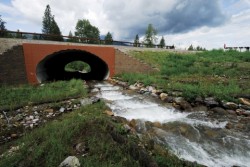News & Media
Taking the Low Road
Our road and highway system is the Parthenon of American civilization: a massive four-million-mile network that constitutes approximately one percent of all land area in the U.S., supporting around 200 million vehicles annually. When you consider that the environmental impacts of roadways extend beyond the asphalt, roads affect roughly 20 percent of land area, according to Harvard researchers. Not to mention vegetation killed by salt use, water flows altered by de-icing, and habitat fragmentation.
So it’s no wonder that more than one million large animal and vehicle collisions occur each year, killing more than 200 people, injuring another 29,000, and causing $1.1 billion in vehicle damage, according to a March 2010 report by the Federal Highway Administration. In addition, roads create barriers for traveling animals, genetically isolating some populations and affecting ecosystems. This can result in lost hunting and tourism revenues, as wildlife numbers dwindle.
It’s a serious issue here in Montana, and officials with the Montana Department of Transportation have begun incorporating wildlife mitigation features such as fences, culverts, and wildlife passages when building or upgrading state roads. It’s an effort that can reduce animal-vehicle collisions by 80 to 90 percent and significantly reduce habitat fragmentation, according to the Craighead Institute, which worked to establish wildlife fencing along Bozeman Pass: a corridor for wildlife moving north and south in the Greater Yellowstone Ecosystem.
Between January 2001 and June 2010, the institute’s research found that 2,272 animals, representing 49 different species, were killed on Bozeman Pass alone. The majority of animals killed were ungulates, like elk and deer, at 44 percent, followed by meso-carnivores, like coyotes and skunks, at 27 percent.
The institute provided survey data from the first two years of their study to the Montana Department of Transportation, which planned to rebuild a bridge over the Montana Rail Link overpass on I-90 near Bear Canyon. A track bed (a sand pit that shows animal tracks) was constructed in 2004 to document the number of animals crossing there already. It was expanded in 2006 when the bridge was replaced.
“We found [the corridor] really reduced roadkill on the highway, which you’d figure; but it also increased the number of animals moving underneath,” says Lance Craighead, executive director for the institute. Which means that the crossing structure facilitated greater animal movement and thus increased habitat connectivity.
Forty-nine ungulates were killed in the area during the four and a half years before the fencing installation. Three years after the project was completed, only eight ungulates had been killed. In addition, more animals traveled under the highway, increasing from an average of 4.6 to 7.2 per day. Successful mitigation measures like these are popping up across the state, as local governments realize their cost-effectiveness—the reduced vehicle damage and medical services alone far outweigh the building costs. Time will tell if public opinion and political impetus will allow the effort to grow, and culminate in wildlife crossings on every major roadway.
Find out more about wildlife crossings in the Bozeman Pass at craigheadresearch.org.
![ARC [diagram]](https://arc-solutions.org/wp-content/themes/arc/images/arc-diagram.jpg)

